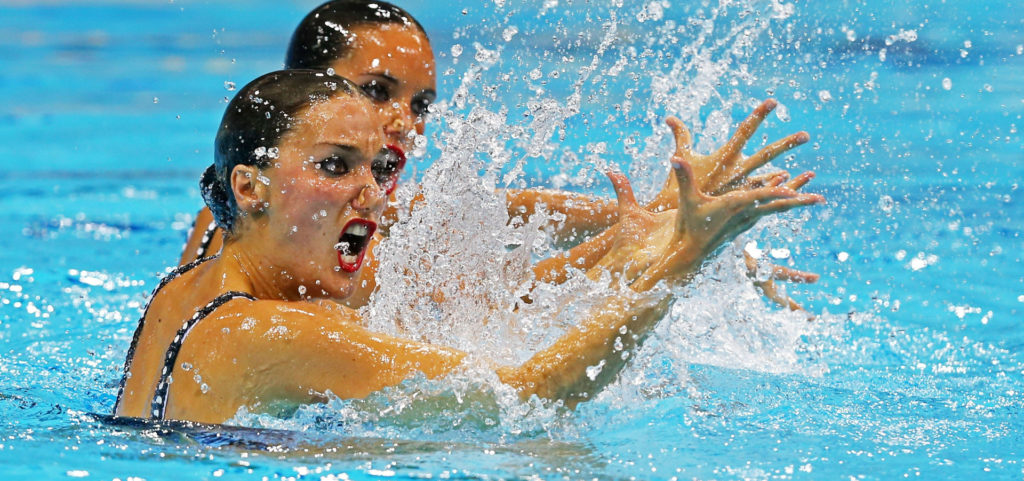
Synchronized swimming, also known as artistic swimming, is a hybrid sport that blends elements of swimming, dance, and gymnastics. Athletes perform choreographed routines set to music while suspended in water. Synchronized swimming first appeared as a demonstration sport at the 1952 Summer Olympics in Helsinki and later became an official Olympic sport in 1984. Over the decades, synchronized swimming costumes have evolved considerably to accommodate the athletic and artistic demands of the sport.
Early Costumes: Focus on Style
In the early days of synchronized swimming, dating back to the 1930s, costumes were relatively simple. Athletes wore basic one-piece swimsuits made of cotton jersey that offered full body coverage for modesty. Some suits had attached skirts for a touch of style during lifts and throws. Costumes were predominantly black, white, and red, and embellishments were added through belts, sequins, and lace trims. While these early costumes were fashionable, they restricted movement in the water. The heavy fabrics absorbed water and created drag during routines. Many early swimmers resorted to improvising their own suits by removing skirt panels and trimming embellishments. This allowed greater ease of movement, even if the aesthetic suffered.
Mid-Century Changes: Nylon and Two-Pieces
In the 1950s and 1960s, swimwear fabrics advanced with the development of spandex and nylon blends. This allowed for greater stretch and breathability in swimsuits. Additionally, the traditional one-piece shifted to a two-piece style for synchronized swimmers, comprising separate tops and bottoms. Two-pieces provided more flexibility and range of motion needed for complex choreography. They also showcased athletes’ upper body strength and endurance. However, mid-century costumes still prioritized aesthetics over function. Decorative sequins, beads, and lace created drag during routines, while loose fabrics impeded smooth execution of moves.
Late 1900s Onward: Focus on Functionality
By the 1970s, synchronized swimming had grown increasingly competitive and athletic. This demanded swimsuits that enhanced performance. Modern suits moved to high-tech fabrics like lycra, which offered lightweight compression. Sequined and beaded embellishments were nixed, allowing for faster movement through the water. Caps became mandatory to smooth hair back and avoid disruption underwater. Full leg coverage became common to streamline kicks and spins. Today’s Olympic synchronized swimmers opt for functional, non-decorative costumes with strategic seam placement to facilitate choreography execution. Artistic flair is achieved through music choice and routine choreography. Each detail of contemporary competition suits is carefully considered for its impact on athletic performance and artistic impression.
Key Innovations
Several key innovations over the last century contributed to the high-performance synchronized swimming costumes seen today. These include:
- Shift from cotton to elastic, high tech fabrics like spandex and lycra for compression and range of motion.
- Replacement of skirts and embellishments with flat stitching to reduce drag.
- Greater use of back and shoulder support design features.
- Open back styles to ease breathing and underwater mobility.
- Full leg coverage for fluid kicks, eggbeater motions, and spins.
- Chlorine-resistant fabrics to maintain durability through extensive water exposure.
- Development of matching head caps to tie looks together.
- Strategic use of mesh panels for ventilation and quick drying.
- Advancements in suit lining to prevent transparency when wet.
- Boning and structured cups for support during lifts and throws.
- Contouring and control panels for smoothing and streamlining shape.
- Reinforced seams in high friction areas for durability.
- Carefully placed decorative elements that enhance but don’t hinder routines.
- Computerized laser cutting for seam precision.
- 3D pattern design techniques.
- Use of compression materials to prevent suit slippage.
- Anti-slip grip dots on knee and elbow areas.
- High necklines for secure suit placement.
All in all, synchronized swimming costumes have undergone an impressive evolution from their early beginnings as fashionable swimwear to today’s athletic competition suits. Advances in textile technology and increasing athletic demands prompted key innovations that transformed costumes into performance enhancers. While synchronized swimming has strong artistic roots, costumes now prioritize function over style. Contemporary suits allow elite athletes to execute challenging routines with flexibility, support, and streamlined movement. Synchronized swimming’s unique fusion of art, athletics and technical skill is enabled, in part, by the specialized costumes that have come to define the sport. The ongoing quest for the ideal synchronized swimming costume will likely bring further innovations as the sport continues to evolve. Each generation of swimmers has pushed the boundaries of possibility, and their costumes have advanced in parallel to meet new athletic feats.